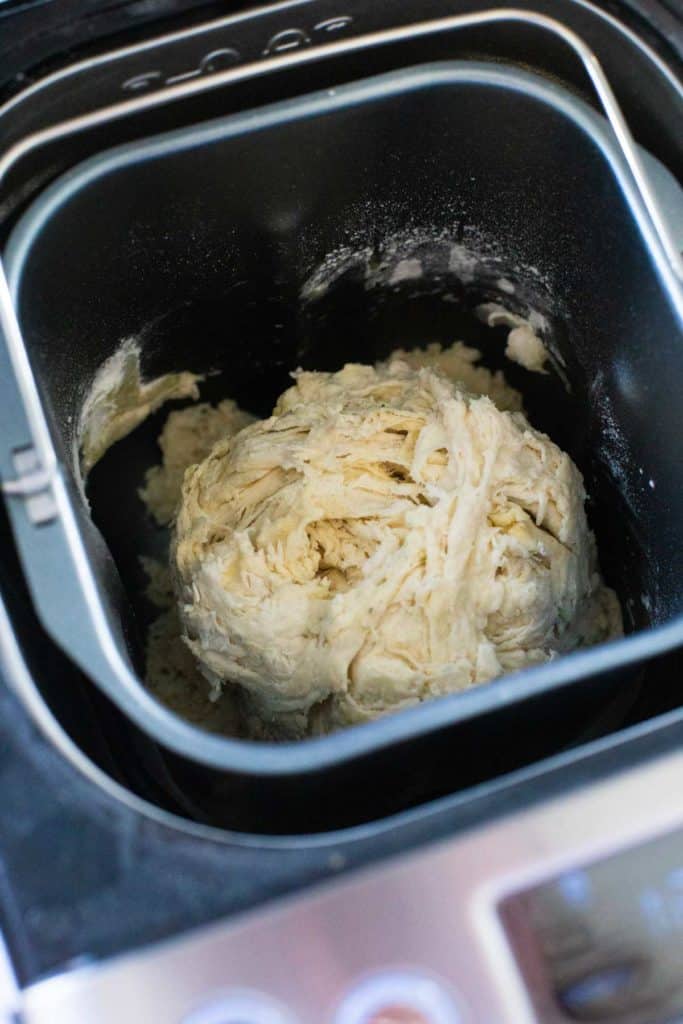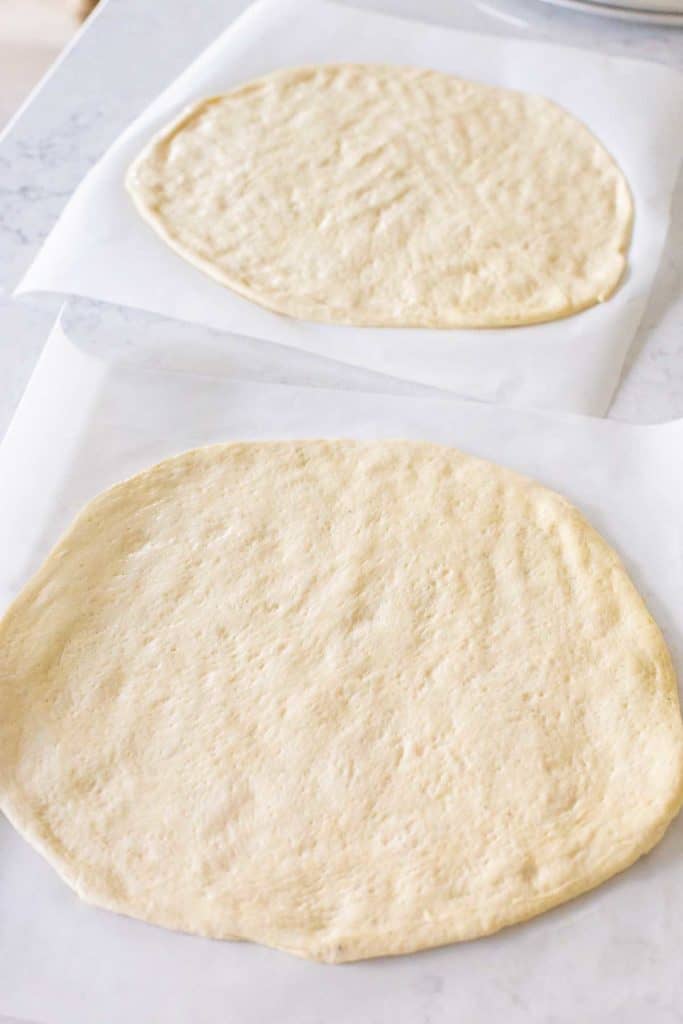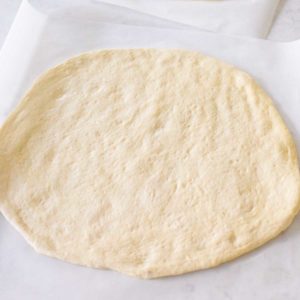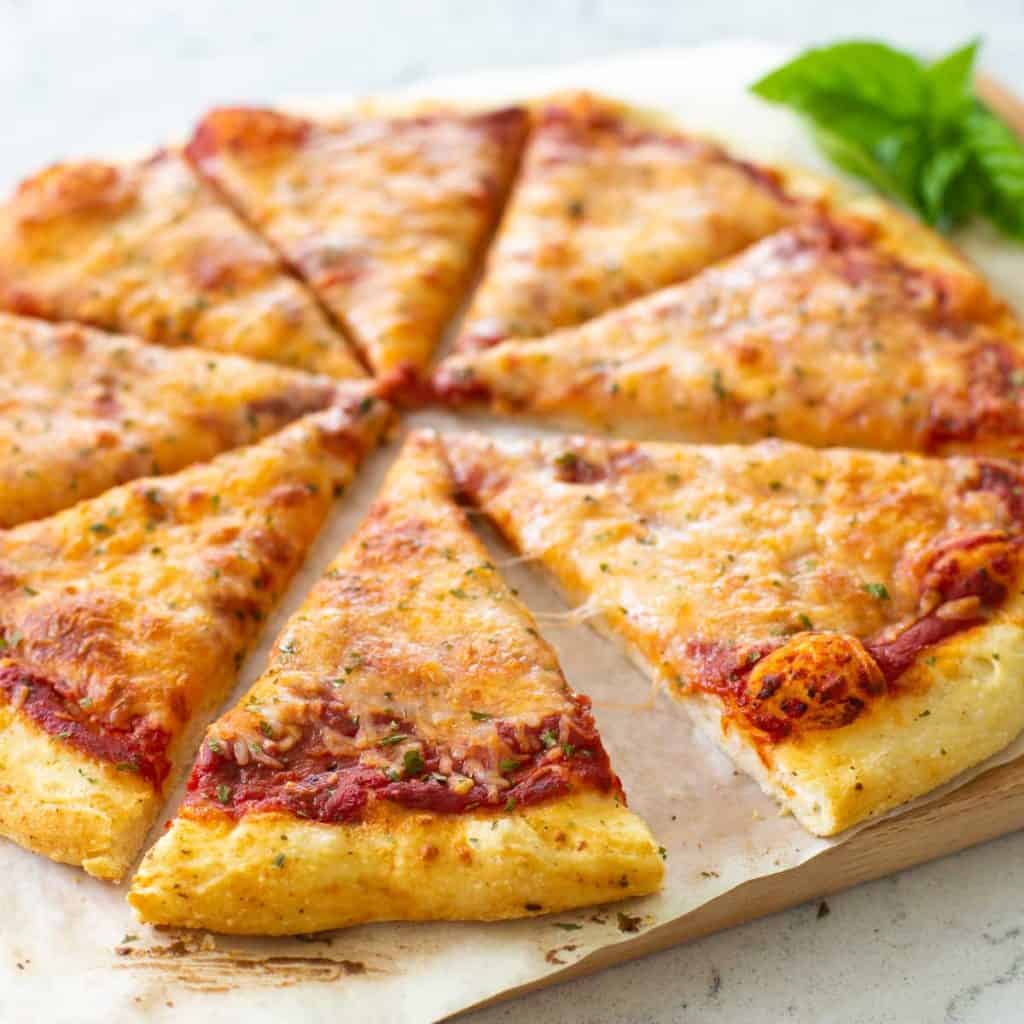Bread Maker Pizza Dough
This foolproof bread maker pizza dough recipe is ready with just 5 minutes of hands-on time. Add the simple ingredients to your bread machine, press START and a fresh baked homemade pizza will be at your fingertips by dinnertime.

Pizza is practically it's own food group in our family. My husband's love for it is so strong, it got mention during the Best Man's speech at our wedding. So to say we are picky about our pizza would be an understatement.
While we may argue about which toppings make the best pizza, we can all agree you can't have a perfect pizza without a perfect pizza crust.
This homemade bread maker pizza dough is the best you'll find because it only takes a few minutes to measure and add the ingredients to your bread machine bread pan. Simply press the Start button and walk away. The dough will be waiting for you at dinnertime.
When you're ready to roll out the dough, you'll find this pizza crust is easy to form and bakes up with a perfectly crispy crust as long as you follow these tips for how to bake pizza dough in your oven.
Why This is the Best Recipe
I love each of these easy bread machine recipes but I think this is the best bread maker pizza dough recipe because:
- Easy Prep: Just a few minutes with a few ingredients and you'll have homemade pizza dough in no time.
- Perfect Texture: I love the chewy, crispy crust this dough gives a pizza.
- Perfect Flavor: The base recipe of this dough has one of my favorite seasonings. You can also add more flavor by brushing olive oil on the edges and sprinkling more seasoning before baking.
- Fun to Bake: Make a batch of this dough and have so much fun for Friday Night Pizza baking with the kids!
Ingredients

This slightly seasoned bread machine pizza dough has a very short list of ingredients:
- Bread Flour: We use King Arthur Baking flour for almost all of our bread machine recipes. It gives consistent results and I find it rises better than other brands we've used. Don't want to purchase bread flour? See the substitutions section below.
- Extra Virgin Olive Oil: The olive oil will go inside the dough itself as well as get brushed over the pizza crust edge before baking. Make sure you have extra virgin olive oil.
- Active Dry Yeast: This is the only yeast we use in our bread makers. I buy Saf-Instant yeast in bulk and keep it in a storage container in our freezer because we go through it so quickly. If you don't plan to bake often, the individual packets are fine.
- Water: Straight from the tap will be just fine.
- Kosher Salt: Do not substitute table salt or the saltiness will be off.
- Dry Romano Cheese Spice Blend (OPTIONAL): I've fallen in love with this Taylor Street Garlic & Herb Seasoning from The Spice House. I add just a teaspoon to the dough and it gives it a little hint of extra savory flavor. It isn't essential but my whole family loves it.
Texture & Taste
With so few ingredients, the pizza dough will really take on the flavor of the olive oil you use. This is why it is essential to use a high-quality olive oil.
The dough makes 2 12-inch pizza crusts. At that size, the thickness of the pizza crust is similar to a hand-tossed pizza at your favorite pizza delivery place. If you roll your pizzas out larger or smaller, this will affect the bake time and final texture.
The texture of the crust is crispy on the outside and chewy on the inside if you follow my baking instructions in the recipe card.
How to Fill the Bread Pan
If you've never used your bread maker before, the most essential thing to know before you begin is that you ALWAYS add the ingredients to the bread pan in the order they are listed in the recipe.
If you add them in a different order, it will negatively affect the way the bread machine mixes the dough.
The liquids always go in first: Make sure the paddle attachment is in place before you add the water and the olive oil to the pan.
Next, the flour gets added to the pan. At this point, I strongly encourage you to use a food scale to measure the flour. This helps ensure your pizza dough will come out perfectly.
I place the bread pan on the food scale and then turn the scale on. The scale should read "0" but if it doesn't, look for a button that says "Tare" to zero-out the scale. Now you'll be able to add the flour one large spoonful at a time until you get the proper weight.
Add the salt in the corners of the pan, don't dump it right in the middle of the flour. This helps to make sure the yeast and the salt don't touch directly which can kill the yeast and prevent your pizza dough from rising.
If you're using the optional seasoning, add that to the corner of the pan as well.
Lastly, use the back of a spoon to dig a shallow well in the center of the flour. This is where you'll put the yeast.

Once you've added the yeast, the pan is ready for your bread maker.
Want to Save This for Later?
Tips for Using A Bread Maker
Secure the bread pan into place and then select the DOUGH program. Some machines have multiple options for making dough. You don't need "Artisan Dough" or "Crusty Bread", just the regular "Dough" option will be perfect.
For the 5 models of bread machines we tested, the Dough program took 1 hour and 30 minutes on each of them.
First, you bread machine will mix together the dough and form a rough dough ball. This takes just a few minutes and is really the only stage where you should keep an eye on the progress.
Even if you measure correctly and weigh your flour, sometimes there's just not enough moisture for the dough ball to properly mix. If your dough is looking dry and shaggy, add a little extra water just 1 teaspoon at a time until the dough comes together and isn't sticking on the sides of the bread pan.
This is what the dough looks like when it is too dry:

See how the dough is sticking to the sides of the pan? Also notice how the dough looks craggy and clumpy.
I added just ONE teaspoon of extra water and then dough came together and looked like this:

See how there's no more dough sticking to the sides of the pan? Now the dough ball looks smooth and complete.
If your pizza dough ball doesn't look like that within the first 4 minutes of mixing, add just a little sprinkle of water and scrape the sides of the bread pan with a non-stick safe spatula, making sure to keep the spatula away from the turning paddle.
Once your dough ball has come together, shut the lid of the bread maker and you're free to do anything else you want for the next hour and thirty minutes.
When the Dough program is complete, your pizza dough should have risen and mostly filled your bread maker pan. The dough should be soft and smooth looking look like this:

Prepare the Second Rise
You're almost there! Your pizza dough is now properly prepared but it needs one more little step before you bake with it.
Brush the inside of a large mixing bowl with extra virgin olive oil. Transfer the pizza dough to the bowl and gently press it with your fingers to deflate it.
Cover the bowl with plastic wrap and place it in a warm place to do a second rise.

I like to place the bowl on my stovetop. When I preheat the oven for baking the pizza, the bit of warmth helps the dough rise just a little more before I work with it.
After another hour, your dough should have doubled in size like this:

Now you're ready to shape and bake your homemade pizza!
Recipe FAQs and Substitutions
Bread flour has a higher protein content than regular all purpose flour does. If you substitute them, it may affect the rise of the dough but it should still work. Keep an extra careful watch on the mixing phase of the bread machine, the dough may be dryer with all purpose flour and you may have to add a little more water to get the right consistency.
Yes, bread machine yeast is the same as instant yeast and can be used interchangeably in your bread maker in a 1:1 ratio.
There are 2 1/4 teaspoons in a single packet of instant yeast. This recipe calls for just 2 tsp so you won't want to use the entire packet. Measure out the 2 tsp and discard the remaining yeast. This is the greatest benefit of buying your yeast in bulk. You can always measure just what you need without wasting any leftover.
How to Store the Pizza Dough
If you don't want to bake pizza right away, this dough keeps perfectly in the fridge for several days.
Make the Dough Ahead
Follow the recipe right up to the point where the bread maker has completed the Dough program. Transfer the pizza dough to a mixing bowl that comes with a lid. Brush the bowl with olive oil.
Turn the dough over once so the ball is coated in oil and cover the surface of the dough with plastic wrap. This will help keep the dough fresh and prevent it from drying out. Place the lid on the bowl and place the bowl in your fridge for storage.
How to Use Pre-Made Pizza Dough
Your pizza dough isn't quite ready-to-go at this point. It still needs to do the second rise.
On the night you want to bake pizza, simply take the bowl out of your fridge 2 hours before you want to cook so it has time to come to room temperature and then finish the second rise.
Remove the lid and surface plastic wrap. Cover the bowl with a clean towel or a fresh piece of plastic wrap and place the bowl in a warm place to rise.
Soon you'll be ready to roll out the pizza crust and get dinner started.

Easy Pizza Ideas
With this delicious pizza dough, you can make an endless combination of homemade pizzas or flatbreads, including breakfast pizza.
You could even use this pizza dough to make homemade pizza buns!
Here are some of our family's favorites:
📖 Recipe

Bread Machine Pizza Dough
Ingredients
- 1 cup water lukewarm
- 2 tbsp extra virgin olive oil
- 3 cups (411 g) bread flour
- 1 1/4 tsp salt
- 1 tsp Taylor Street seasoning optional, see note
- 2 tsp instant yeast
Instructions
To Make the Dough
- Add the ingredients in the order they are listed to your bread machine's bread pan fitted with the paddle attachment.
- Select the Dough program and press "Start". Most machines take about an hour and a half to complete the cycle.
- Brush olive oil around the inside of a large mixing bowl. Transfer the dough from the bread pan to the bowl and remove the paddle. Gently punch the dough down and turn it over in the bowl so that it is covered in the oil. Cover the bowl with plastic wrap or a clean towel.
To Store the Dough
- If you don't want to bake with the dough today, you can place the covered bowl in the fridge and leave the dough for up to 3 days.
- Plan to move the bowl to a warm spot in your kitchen 2 hours before you want to bake so that the dough can come to room temperature and then rise.
To Use the Dough
- Place the covered bowl of dough on your stovetop or another warm spot in your kitchen and let the dough rise for 1 hour. (If the dough was refrigerated, add an additional hour.)
- Place a pizza stone on a rack in the center of your oven and preheat to 450°F for at least 30 minutes.
- Transfer the pizza dough to a baking mat. Do not flour the mat, you want the dough to stick a little bit so it is easier to pat into shape. Use a bench scraper or pizza wheel to cut the dough in half. Put one half back in the oiled bowl while you pat out the first crust.
- Use your fingers to pat the dough into a 12-inch circle. If the dough insists on shrinking, let it rest for 5 - 10 minutes and try again.
- Place a piece of parchment paper over the pizza crust and smooth out the air bubbles. Roll up the baking mat, flip it, and unroll the mat so the parchment paper is now on the counter and the baking mat is on top. Peel back the baking mat, you should now have the pizza crust sitting on parchment paper.
- Brush olive oil around the edges of the crust and then top with your favorite pizza toppings.
- Repeat with the second half of the dough.
To Bake the Pizza
- To get the crispiest crust, you'll want to bake the pizza on the parchment paper directly on the hot pizza stone in the oven. For a softer crust, you can place the pizza on a metal pizza pan and bake it on the hot stone.
- To get the pizza onto the hot stone without spilling, it is a good idea to slide the pizza on the parchment to a metal pan and use it as a "pizza peel" to carry it to the oven. Rest one edge of the pan on the hot stone and carefully slide the parchment off the pan and onto the stone.
- Bake the pizza for 12 - 15 minutes or until the edges are golden brown and your toppings have melted and are gently bubbling.
- To remove the pizza from the stone, use a metal pan and slide the parchment off the stone onto the pan.
Recipe Notes
Save This Recipe to Your Recipe Box
Find this delicious recipe next time you visit by saving it to your very own recipe box on my site. All your favorites stored in one easy place!












That is perfect pizza dough. You are my hero. Even my husband who hates pizza loved this!
Thank you!
This was exactly what I needed to hear today https://www.peanutblossom.com/blog/bread-machine-pizza-dough/ tnx for this
Wow...thank you for this recipe! I made the dough today for the best home pizzas we've ever had. Let mine rise a bit more than you wrote (2 hours instead of 1). Also use a cast iron pizza insert for the oven that really works well. It turned out amazing! Perfect mix between thin and medium crust with just the right blend of crunch to chew. Had those big burnt looking pillow bubbles like the pizza in Italy. We enjoyed it so much! The parchment paper trick is a total game changer. Thank you!
Yay! I'm thrilled to hear your pizza night was a success. Thanks for sharing your feedback!
Returned to add that I bought the Kindle version of your book "The Ultimate Bread Machine Cookbook" from Amazon based on this recipe and a few of your others that I've tried. Some really good tips and recipes there. Was definitely worth the purchase. Thank you for the delicious inspiration!
Oh my goodness, thank you so much for your comment Alan. You have no idea how much that means to me. I'm thrilled you enjoyed the cookbook and I hope you have plenty of tasty breads coming to your table soon.
Tiffany
I'll admit, I'm a bit new at this so please bare with me. I find it so confusing reading recipes that tell how much flour to use, in cups and grams. You say to use 3 cups, (411 grams), that would be 137 grams per cup. Most all bags of flour I've seen show that they are about 120 grams per cup. Also, see this web site on how to measure flour (King Arthur APF brand is shown but their bread flour shows the same weight - 30g per cup shown on bag):
https://www.webstaurantstore.com/blog/4372/how-to-measure-flour.html
So when I think of attempting to use your recipe, I'm left with a dilemma. Do I use 3 cups (360g) or your 411 grams?
Hello Alex, I'm just seeing this recipe, so excuse the late response. Firstly, I would use a dry (not liquid pyrex, etc...) measuring cup. Many people stick a dry measuring cup/scoop in the bag. Sadly, this is not effective and leads to issues re: bread density/rise due to inconsistent amounts of flour (often too much because of compaction).
Easy solution... grab a plate and place your measuring cup on it. Spoon in the flour until mound forms. Do not pat down... instead shake cup side-to-side and backward-to-forward until level. The excess flour will fall onto plate. You can then pour excess flour back into bag (after measuring all cups, of course).
I hope this helps. I make loads of fresh bread and the above technique never fails me. Years ago, I used the measuring cup in the bag option because it seemed simple.... dragging cup along inside of the bag and seemed perfect, until I realized that cup was really ~1.25 cups +/- and causing breads to fall short. No sense in wasting ingredients.
Tiffany, awesome recipe, thanks!
Do you have instructions for a mixer vs bread machine?
Tried this for the 1st time today and it was perfect!!! We've used the store bought pouch dough in the past and I'll never buy it again after doing this! Easy and the taste can't be beat. Next up is making and freezing the dough. Thanks for sharing your recipe. I wish I could post a photo of my pizza. 😉
Made just as the recipe instructed minus the seasoning mix which I didn’t have. Made three huge calzones. Dough got nice and crusty on the outside and soft on the inside. Super easy to make. Saved in my “best of” board so it will now be my go to. I’m adding pizza to my menu fir next week just to make this dough again. Thank you for sharing
Tried your bread machine pizza dough, it came out fantastic, in fact my family thinks it is better than pizza from Italian restaurant. Can you freeze the dough? I am making a few more batches of dough, to put away for next week.
I was thinking the same thing. Can it be frozen?